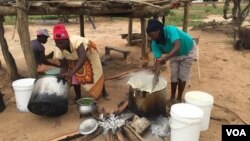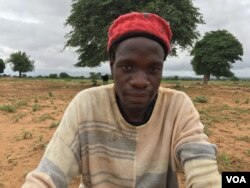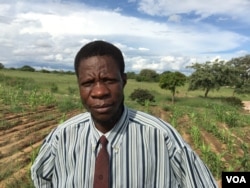Here at Chachacha village in southeast Zimbabwe, men force their cattle into a truck bound for market.
Drought brought on by particularly severe El Nino weather patterns has left 14 million people across Zimbabwe and southern Africa without enough to eat. The current rainy season has been the driest in 35 years, according to the U.N. World Food Program.
Johannes Chibvongodze is among the people selling his cattle because he can't afford to feed them, or buy food for himself and his family. Low rainfall has reduced grazing land.
Chibvongodze says jobs are hard to come by, and families are competing with others coming over from Mozambique.
While this year's rains finally came, it was too late to save many crops from the drought.
“For me to plant anything new now,” Chibvongodze said, is not “a workable solution.”
Need for assistance
The capital of Harare is about 600 kilometers away, and locals say government assistance has been slow to arrive.
The U.N.'s Food and Agriculture Organization has been supplying herders in Chipinge district with feed at reduced prices to help them fatten their cattle.
And some farmers in Chipinge are busy planting, although the Zimbabwe meteorological services department announced last week that the already-shortened rainy season will end in mid-April.
But the question of what to plant is a tough one.
"We would rather encourage farmers to go for small grains — especially the finger millet, pearl millet and sorghum — because they are a bit tolerant in terms of drought,” said Taringana Makiwa of the state-owned Agricultural Extension Service, which advises Zimbabweans on farming. “Most of our farmers used to go for maize crop. In terms of cultivation, it is easy compared to the small grains, but at the end of the day, in terms of yield, we really reap nothing. So the small grains are a bit drought-tolerant. So at least farmers will get something out of it."
But Zimbabweans continue to prefer maize. It is used to make a popular, thick porridge called sadza, made of corn meal and served with relish. Most households eat sadza twice a day, at lunch and dinner.
The price of corn meal has already risen in local markets due to shortages.
The government says it needs $1.6 billion in international assistance to import grain and provide other relief, an estimate international aid agencies have judged too high.
The United Nations says it has raised about $80 million for food assistance to Zimbabwe. China also donated $24.6 million worth of rice to Zimbabwe in March.
The people of Chipinge hope help will come fast. Selling off their animals may be a short-term solution, but it only makes them more vulnerable for the year to come.












